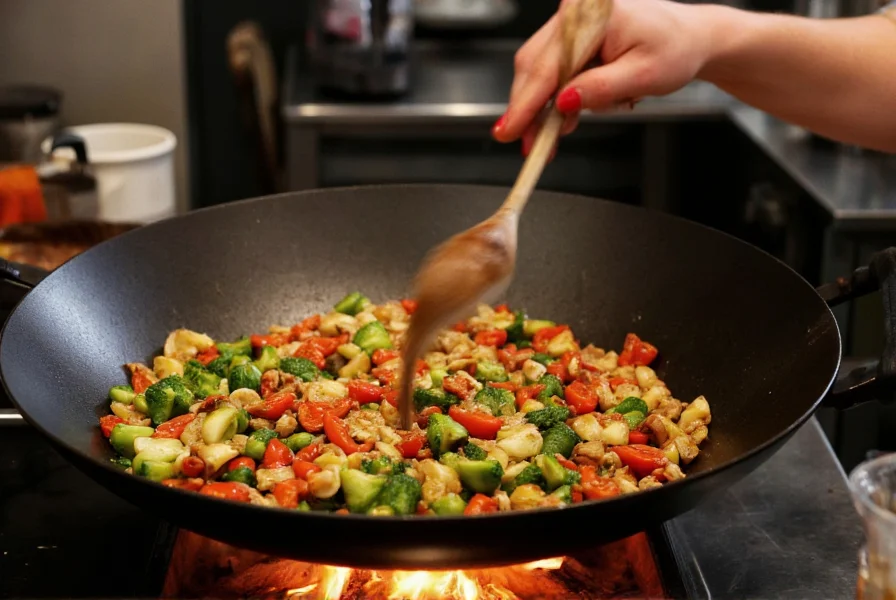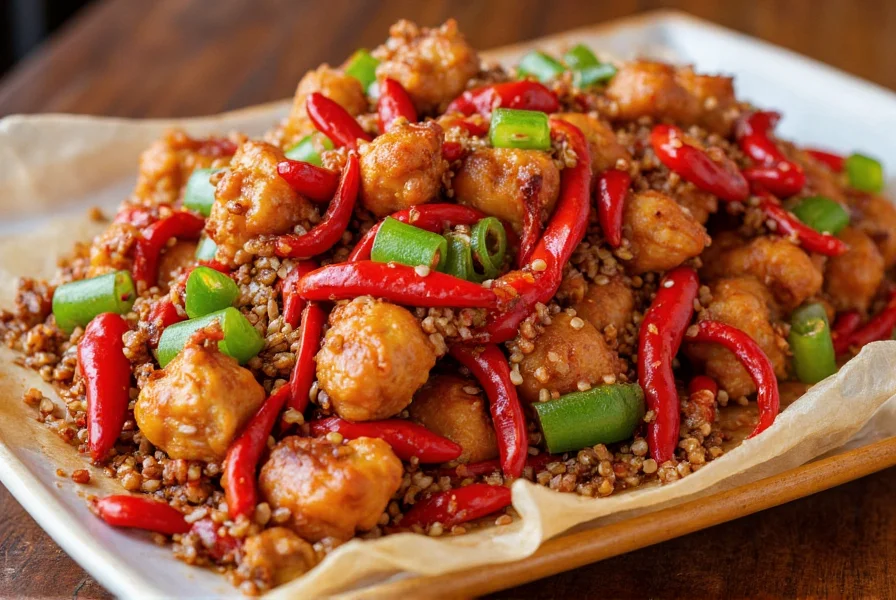Understanding the Essence of Chili Wok Cooking
Chili wok isn't a single dish but rather a versatile cooking approach fundamental to Chinese cuisine. This technique leverages the unique properties of a traditional carbon steel wok to create dishes where chili peppers play a starring role rather than just providing background heat. The magic happens through the combination of intense heat, proper oil temperature, and precise timing that defines authentic wok cooking.
Unlike Western frying pans, a wok's curved shape concentrates heat at the bottom while allowing ingredients to be pushed up the sides to cook at different rates. When preparing chili wok dishes, this design enables chilies to release their essential oils without burning, creating complex flavor layers that simple sautéing cannot achieve.
The Historical Roots of Chili in Chinese Wok Cooking
While chilies are now synonymous with Sichuan and Hunan cuisines, they're actually relative newcomers to Chinese cooking. Originating in the Americas, chilies were introduced to China through maritime trade routes in the 16th century. Initially used medicinally, they quickly became culinary staples, particularly in regions with humid climates where their warming properties helped combat dampness.
The integration of chilies into wok cooking represented a culinary revolution. Traditional Chinese cooking relied on Sichuan peppercorns and ginger for heat, but chilies offered a different dimension of spiciness that chefs expertly incorporated into the existing wok cooking framework. This fusion created now-iconic dishes like gan guo (dry-fried dishes) that showcase the chili wok technique.
Essential Components for Authentic Chili Wok Dishes
Creating successful chili wok dishes requires attention to several critical elements:
Chili Selection and Preparation
The type of chili used dramatically affects the final dish. Common varieties include:
| Chili Type | Heat Level (Scoville) | Best For |
|---|---|---|
| Dried Chinese Red Chilies | 15,000-30,000 | Stir-fries, sauces, dry-fried dishes |
| Fresh Thai Bird's Eye | 50,000-100,000 | Quick-cooking dishes, finishing heat |
| Sichuan Facing Heaven | 40,000-60,000 | Traditional Sichuan recipes |
| Long Green Fresh | 500-2,500 | Milder dishes, vegetable stir-fries |
Professional chefs often combine multiple chili types to create complex heat profiles. Dried chilies should be briefly toasted in oil to release flavors without scorching, while fresh chilies work best added at specific cooking stages depending on desired heat intensity.

Wok Selection and Maintenance
Not all woks deliver authentic chili wok results. Traditional carbon steel woks remain superior for this cooking method due to their heat responsiveness. Key features to look for:
- Material: 1.5-2mm thick carbon steel (avoid non-stick coatings which can't withstand required temperatures)
- Shape: Round bottom for gas stoves, flat bottom for electric (traditional round bottom creates better heat concentration)
- Handle: Single long handle plus helper handle for safe maneuvering during vigorous stir-frying
Proper seasoning creates the non-stick surface essential for chili wok cooking. After each use, clean with hot water only (no soap), dry thoroughly, and apply thin oil layer before storage. A well-maintained wok develops a natural non-stick patina that enhances flavor development.
Mastering the Chili Wok Technique: Step-by-Step
Authentic chili wok cooking follows a precise sequence that maximizes flavor development while preventing bitterness from the chilies:
- Heat the wok until smoking hot (this is critical for wok hei)
- Add oil and swirl to coat entire surface
- Fry dried chilies first for 15-30 seconds until fragrant but not blackened
- Add aromatics (garlic, ginger, scallion whites) and stir briefly
- Add primary protein and sear quickly
- Add vegetables in order of required cooking time
- Finish with sauce and toss vigorously to coat
- Add fresh chilies if using for final heat burst
- Finish with finishing elements (sesame oil, vinegar, scallion greens)
The entire process should take 3-5 minutes for most dishes. The key is maintaining high heat throughout while constantly moving ingredients. When executed properly, you'll achieve the distinctive wok hei—that smoky, slightly charred flavor that defines exceptional stir-fries.
Popular Chili Wok Dishes and Regional Variations
While chili wok refers to the cooking technique, several signature dishes showcase this method:
Sichuan-Style Chili Chicken (La Zi Ji)
This iconic dish features crispy fried chicken tossed with copious dried chilies and Sichuan peppercorns. The chilies provide visual drama and gradual heat release, while the peppercorns deliver the characteristic ma la (numbing-spicy) sensation. Authentic versions use a 1:1 ratio of chilies to chicken by volume.
Hunan Dry-Fried Beef ( Gan Beef)
Hunan cuisine emphasizes fresh chili heat rather than Sichuan's numbing spice. This dish features thinly sliced beef stir-fried with fresh red and green chilies, garlic, and fermented black beans. The "dry-fried" technique means minimal sauce, allowing the chili flavors to shine through.
Chili Garlic Shrimp
A popular adaptation that works well for home cooking, this dish combines plump shrimp with generous amounts of minced garlic and fresh red chilies. The key is cooking the shrimp just until opaque before adding the chilies to preserve their bright flavor.

Avoiding Common Chili Wok Mistakes
Many home cooks struggle with chili wok dishes due to these frequent errors:
- Insufficient heat: Wok must be smoking hot before adding ingredients
- Overcrowding: Cook in batches to maintain proper temperature
- Burning chilies: Dried chilies should toast until fragrant but not blackened
- Incorrect oil: Use high smoke point oils like peanut or avocado oil
- Improper timing: Add chilies at precise moments for optimal flavor release
- Excessive sauce: Authentic chili wok dishes feature minimal sauce to highlight chili flavors
For best results, prepare all ingredients before heating the wok (mise en place). The cooking process happens too quickly to measure ingredients mid-stir-fry.
Perfecting Your Chili Wok Skills: Pro Tips
Take your chili wok cooking to professional levels with these expert techniques:
- Chili preparation: Remove seeds from dried chilies for less intense heat while maintaining flavor
- Layering heat: Combine different chili types for complex heat profiles (e.g., dried for base heat, fresh for brightness)
- Temperature control: Push ingredients up wok sides when adding new components to maintain overall heat
- Sauce integration: Mix sauces before adding to ensure even distribution
- Finishing touches: A splash of Chinese black vinegar or rice wine just before serving enhances complexity
Remember that chili wok cooking is as much about texture as heat. The goal is to achieve ingredients that are cooked through but still vibrant and crisp, with chilies that contribute flavor rather than just overwhelming heat.
Pairing Suggestions for Chili Wok Dishes
Balance the intense flavors of chili wok dishes with these complementary pairings:
- Rice: Steamed jasmine or short-grain rice to absorb flavors and moderate heat
- Side dishes: Mild cucumber salad or steamed bok choy to provide cooling contrast
- Drinks: Lightly sweetened iced tea, barley water, or crisp lager beer
- Desserts: Mango pudding or red bean soup to soothe the palate
When serving multiple chili wok dishes, vary the heat levels and primary proteins to create a balanced meal experience. Start with milder dishes and progress to spicier preparations.











 浙公网安备
33010002000092号
浙公网安备
33010002000092号 浙B2-20120091-4
浙B2-20120091-4